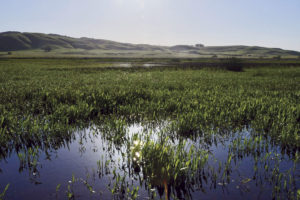When Greg Sarris of Santa Rosa, an adopted child, learned that his paternal grandmother was a Coast Miwok, it opened the door to a whole alternative culture. He would soon begin to explore that heritage, absorb it, and work to present it to the world—not as an activist at first, but as a novelist and scholar.
In 1992, he learned of a proposed casino on the shore of Tomales Bay, to be built in the name of a Northern California Indian group under a new law that exempted recognized tribes from local land use controls. Sarris objected both to the use and to the non-Miwok sponsors. “Those were our sacred grounds,” he says. “Those people from Cloverdale didn’t belong down here.”
Sarris spent the next eight years working to organize the legitimate remnants of the Coast Miwok and Southern Pomo Indians, a mixed community clinging to its identity on a scrap of land near Healdsburg. As one of his last acts in office, President Bill Clinton signed the bill—authored largely by Sarris himself—recognizing the Federated Indians of Graton Rancheria.
Unfortunately, recognition did not bring a budget with it. After several years of looking for another economic base, the tribe, which had elected Sarris as its chair, turned to the expedient it had hoped to avoid: a casino. A partner was found who acceded to all the tribe’s conditions (including the use of green construction and union labor) and located what looked, commercially at least, like the ideal site: the busy, but vacant, intersection of the Lakeville Highway and Highway 37 at Sears Point.
The ensuing furor left Sarris unmoved. But then he read an analysis put out by The Bay Institute, the Sonoma Land Trust, and the Sonoma Ecology Center, showing how the project would doom any hope for a continuous sweep of restored wetlands along Highway 37. Sarris put in a call to Marc Holmes, the Bay Institute’s point man for the area. “That single conversation,” Sarris says, “changed my mind.” The result, a few months later, was an agreement that made the Federated Indians a partner in the preservation of 2,327 acres at Sears Point.
The casino plan (still attracting debate) has been shifted to the urban fringe in Rohnert Park. Sarris is determined to see it through. He is equally determined to use much of the eventual revenue for larger purposes, like purchasing and managing Sonoma County open space. “Our dream,” he says, “is to once again take our place as caretakers of our aboriginal lands.”

.jpg)



-300x182.jpg)